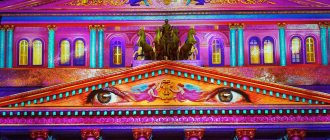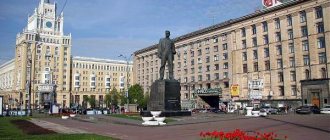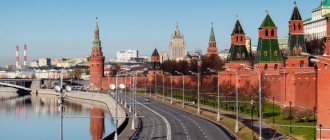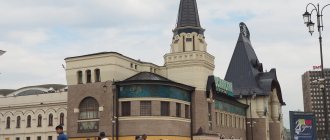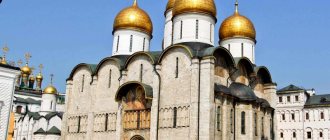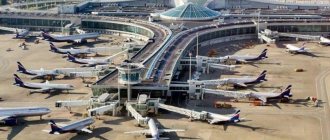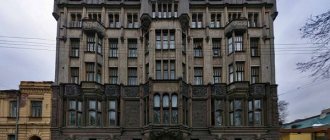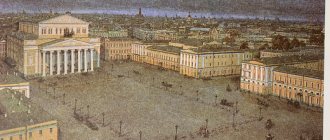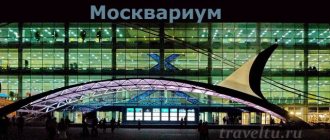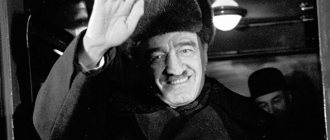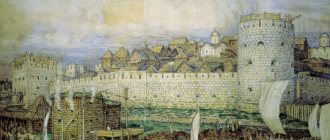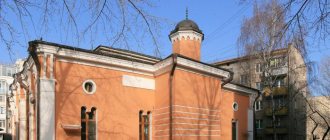Moscow, as the capital of our Motherland, can be called the heart of Russia, then the Kremlin can be called the heart of Moscow. And if we continue to follow this logic, then Cathedral Square is the very heart of the Kremlin. So it turns out that today we have an excursion to the very heart of our vast Motherland - to Cathedral Square of the Moscow Kremlin.
Everyone who has ever been to Moscow has visited Red Square. And how could it be otherwise? After all, Red Square is the main square of Russia. Anyone who has not been to Moscow knows the Kremlin well from postcard views and New Year’s greetings from the president. Of those who were on Red Square, not everyone went beyond the walls of the Kremlin, but meanwhile there is no less interesting behind the Kremlin wall than outside. We included the Kremlin Cathedral Square as an obligatory part of the program of walking around Moscow.
In addition to the walk along Cathedral Square itself, you can also visit the Armory Chamber, where the Monomakh cap and the crown of the Russian Empire are kept, take a guided tour to the observation deck of the Ivan the Great Bell Tower and look at the changing of the horse and foot guards. All options for excursion programs and their prices can be found on the official website of the Moscow Kremlin.
Where it all began
The strengthening of the economic position of the Moscow principality led to the beginning of the construction of majestic churches and cathedrals. Princes Dmitry Donskoy and Ivan Kalita ordered the construction of churches, which later determined the layout structure and spatial composition of the square. Unfortunately, the original structures have not survived. During the reign of Ivan the Third, new churches worthy of the capital of the great Russian state were erected in the same places.
History of the Moscow Kremlin
During archaeological research, it was discovered that in the place where the Archangel Cathedral is now located, there was a Finno-Ugric settlement back in the Iron Age. The first chronicle mention of Moscow dates back to 1147, according to it, not far from the confluence of the Neglinnaya River with the Moskva River on Borovitsy Hill there was a fortified village. The first fortress on this site was built in 1156; it was typical of those times: wooden walls, an earthen rampart and a moat. However, the citadel was destroyed by the Mongol-Tatars in 1238. In 1339 new oak walls were built. Even then, on the territory of the Kremlin, the oldest Moscow temple was located - the Cathedral of the Savior on Bor (it was destroyed in 1933). It served as the tomb of the Moscow princes (later this role passed to the Archangel Cathedral).
In 1367, during the reign of Dmitry Donskoy, walls of white stone were built. It was from those times that the name “White Stone Moscow” appeared. Wooden walls were replaced with stone ones not along the entire perimeter of the fortress, but only in the most vulnerable places. In the 15th century, during the reign of Ivan III, the Moscow Kremlin was rebuilt again. The work is being carried out under the guidance of Italian architects. This time the material used is baked brick. The towers and walls with loopholes in the form of swallow tails built then have survived to this day. However, the Moscow Kremlin acquired its modern appearance in the 17th century - then the tents on the towers were completed.
In 1812, the Moscow Kremlin was captured by Napoleon's army. However, the French emperor’s stay in the “heart” of Moscow was short-lived - he fled the very next day due to the threat of fire. During the retreat, he ordered the Kremlin to be mined. The explosion caused serious damage.
It is known that from the beginning of the 18th century until the October Revolution, the capital of Russia was located in St. Petersburg. The Kremlin was the Moscow residence of the emperor, but he did not appear here often. In this regard, the territory of the Moscow Kremlin was free to visit. Anyone could go inside the fortress walls, take a walk, and see the architectural sights.
During the revolution in 1917, the buildings of the Moscow Kremlin were heavily damaged by artillery shelling.
After the overthrow of the autocracy, the capital was moved to Moscow. The Soviet government, headed by V.I. Lenin, is based in the Kremlin. Ordinary citizens are prohibited from entering here. In those years, monuments related in one way or another to the autocracy were destroyed. Church buildings were not spared either. For example, in 1929–1930. The Chudov and Ascension monasteries, which have been located on the territory of the Moscow Kremlin since ancient times, were demolished. The eastern part of the territory was reduced to ruins. Later, the most ancient temple in Moscow, the Cathedral of the Savior on Bor, was destroyed. Various institutions (hospital, gym, club, etc.) were set up in palaces and surviving cathedrals.
During the Great Patriotic War, the Moscow Kremlin was carefully camouflaged, which helped to protect it. The mausoleum was covered with a fake building, the stars were removed from the towers, images of building facades were painted on the walls, etc.
In 1990, the Moscow Kremlin was included in the UNESCO World Heritage List. The exception was the Grand Kremlin Palace. Apparently they thought that its architecture did not fit into the architectural ensemble.
Purpose of the object
From the very beginning of its appearance, Cathedral Square of the Moscow Kremlin was used for various ceremonies and processions. During royal weddings, coronations and on great church holidays, crowded events were held on its territory. The place at the porch of the Palace of Facets was intended for the ceremonial meeting of foreign ambassadors. The square was crossed by funeral processions to the final resting place of patriarchs, metropolitans, kings and grand dukes.
Cathedral Square in Moscow in the eighteenth and nineteenth centuries was paved more than once with stone slabs made of sandstone. For several decades of the twentieth century it was paved. During the reconstruction of 1955, the square regained its stone covering.
How to get to the Kremlin's Cathedral Square
To ensure security, there is only one entrance to Cathedral Square. It is located in the Kutafya Tower, built in the 16th century. This is the only surviving bridgehead tower of the Kremlin. Such towers served to protect bridges leading to the Kremlin.
Tickets can be purchased at the Moscow Kremlin Tourist Information Center, which is located in the Alexander Garden, not far from the Kutafya Tower. View of the information center from the loophole of the Trinity Bridge.
The Alexander Garden can be reached by metro. Fortunately, this is the very center of Moscow and there are at least a dozen metro stations in the area. The most convenient and closest station to the entrance to the museum ticket office is the Aleksandrovsky Sad metro station and the Lenin Library . Here Vozdvizhenka Street intersects with Mokhovaya Street. All you have to do is pass Sapozhkova Square and you will find yourself near the Kutafya Tower. In addition, you can enter the Alexander Garden from Manezhnaya Square; the Okhotny Ryad . You can also walk from Zamoskvorechye across the Bolshoy Kamenny Bridge. This is advisable, say, if you were in the Tretyakov Gallery in Lavrushinsky Lane, then crossed the Luzhkov Bridge to Bolotny Island, and then walked along the Bolshoi Kamenny Bridge to the Alexander Garden.
Objects that have not survived to this day
The ensemble of Cathedral Square of the Moscow Kremlin has been transformed several times. Initially, wooden structures were erected along the perimeter. Some of them failed to survive the constant fires in the capital, others simply fell into disrepair, after which new ones were erected in their place. Almost all the churches now standing on Cathedral Square had predecessors. The most famous of the now defunct objects are the Church of the Deposition of the Robe, the Temple of the Solovetsky Wonderworkers, the Arkhangelsk, Annunciation and Assumption Cathedrals, and the old Patriarchal Chambers.
There were buildings that were destroyed or seriously damaged by the enemy. This was the case during the Great Troubles (1612) and the invasion of Bonaparte (1812). For example, when the French troops retreated from the capital, the unique Filaret extension to the bell tower of Ivan the Great was destroyed. The same fate awaited the nearby three-span belfry. The Church of St. John the Climacus has not survived either. It was erected by order of Ivan Kalita in 1329. The structure had the shape of an octagon with arches for bells located on the second tier. It was simply dismantled in the fifteenth century in order to free up the territory for the construction of a bell tower in honor of Ivan the Great.
The architectural appearance of the erected temples changed as time required. Some buildings were supplemented with new chapters, covered galleries and other elements.
Temples and churches of Cathedral Square
The complex of buildings on Cathedral Square was founded in the 13th century. In the center is the Assumption Cathedral, the main temple of the Moscow State , where Russian autocrats were crowned kings. Built in the 12th century, the cathedral is modest in appearance. Destroyed to the ground by an earthquake, it was rebuilt in the 15th century by order of Ivan III by the Italian architect Feoranti.
Five powerful domes, smooth walls and rhythmic alternation of windows and windows create an impression of severity and strength. Inside there is a large hall with 4 round columns. An elegant carpet of painting covers the walls and vaults, window jambs and pillars. The fresco composition of the 15th-17th centuries consistently reveals biblical scenes.
The Assumption Cathedral is the tomb of the heads of the Russian Church, metropolitans and patriarchs. The burials are located in the deep underground of the cathedral; on the walls of the temple there are memorial plaques with their names.
Royal coronations took place here, metropolitans and patriarchs were established. Since 1990, worship has been resumed in the cathedral.
The Archangel Cathedral was erected at the beginning of the 16th century according to the design of the Milanese architect Alevaz Fryazin. The appearance is a combination of elements of Italian and Russian architecture. Built of brick, it is decorated with white stone, the complex cornice is decorated with stone carvings.
In the 16th century, 92 artists painted the walls of the cathedral: scenes about the exploits of the Archangel Michael, Old Testament scenes and a “portrait gallery” of Kyiv, Vladimir and Moscow princes.
The cathedral is the burial place of the Moscow ruling dynasty, whose burials are under the floor, and on top are brick tombs with white stone slabs, foliate carvings and the names of the buried.
Ivan Kalita, who united the Russian lands, Prince Dmitry Donskoy and the builder of the Kremlin, Grand Duke Ivan III, are buried here. Behind the iconostasis is Tsar Ivan the Terrible, next to him is the son he killed. Here are representatives of the Romanov dynasty. Starting with Peter, Russian emperors are buried in the Peter and Paul Fortress in St. Petersburg.
The Annunciation Cathedral is located on the southern side of Cathedral Square. Nine-domed, with golden domes and openwork trellises on the roof, the cathedral looks airy and elegant. The inlaid floor in the temple is amazingly beautiful - small pieces of flint with bright inclusions of agate and jasper make it look like a fairy-tale carpet. The impression is enhanced by luxurious wrought iron lamps.
The cathedral's paintings, arranged in cycles, illustrate church holidays and the passion of Christ, miracles and parables. Frescoes - with figures of Russian princes and ancient philosophers. Royal weddings and christenings were traditionally held here, and the treasures of Russian princes were kept for many years.
The Church of the Deposition of the Robe is a small one-domed Kremlin church on Cathedral Square, a home church of metropolitans and patriarchs, built in 1480 by Pskov craftsmen. The temple was erected in honor of the sudden retreat of the Tatars besieging the Moscow Kremlin.
Built of brick, with white stone trim and a hipped roof, the church is connected by a covered gallery with the Royal Terems and the Assumption Cathedral. Divine services are held here once a year during the Patronal Feast of the Icon of the Mother of God of Pechora. The temple is a museum.
The Ivan the Great Bell Tower was built in 1505 on the site of the Church of St. John the Climacus by the Italian architect Fryazin. The first tier was occupied by the temple, on the 2nd, 3rd and 4th tiers there were 30 bells. Later, a Belfry with the Church of the Ascension was built. In 1600, at the behest of Boris Godunov, the bell tower was built to 81 meters. Next to the bell tower is a giant, but never rung, Tsar Bell.
The Faceted Chambers are the oldest civil building in Moscow, where ceremonial receptions and meetings of the Boyar Duma were held. The faceted chambers, built in the style of a Florentine palazzo, currently the representative hall of the President of the Russian Federation, are part of the Grand Kremlin Palace, which is the residence of the President of the Russian Federation.
Inside there is a hall covered with cross vaults, which rest on a pillar placed in the center. The Red (Golden) Porch leads from Cathedral Square into the shadow of the Pomegranate Chamber and is intended for large royal exits. Gilded statues of lions sat on the parapets of the open staircase. The Porch, dismantled in 1930, was restored in 1994.
The Patriarchal Palace with the Church of the 12 Apostles, built in the middle of the 17th century, contains the personal chambers of the Patriarchs with a refectory, patriarchal orders, a house church and economic services. Since 1961 – Museum.
Here on Cathedral Square of the Moscow Kremlin 500 years ago, just as today, the domes and crosses of ancient churches glowed with gold, the Assumption Bell buzzed loudly and the first clock of the state on the Spasskaya Tower struck. This is the merit of our great ancestors, let us bow to them, who left behind such a miracle!
Features of the architectural style
The Cathedral Square of the Moscow Kremlin (photos presented in the article) has some features characteristic of the architectural schools of the Vladimir-Suzdal Principality and Pskov. Masters invited from the two indicated centers of domestic stone architecture, when constructing churches and cathedrals, not only adhered to classical techniques, but also introduced new ones. For example, during the construction of the Church of the Deposition of the Robe, a high basement was made for the first time. The Pskov school had a significant influence on the decorative design of facades. Thus, on many temples you can see curbs, ornamental belts on the drums of domes, runners, and a three-lobed version of the completion of facades. As for the Vladimir-Suzdal school, its influence was maximally manifested in the design of the Assumption Cathedral (narrow windows and an arched belt on the apses).
Cathedrals and temples of the Moscow Kremlin
In the capital of the Orthodox state, as befits, there are many cathedrals and temples. Is not an exception
- The main cathedral of the Moscow Kremlin and the Russian state is the Assumption Cathedral. It is famous for the fact that it hosted the coronation of emperors and the crowning of the kingdom. The election of the heads of the Russian Church and the burial of metropolitans and patriarchs also took place here. Valuable icons are also kept here, and there is an ancient necropolis and place of worship for Ivan the Terrible.
- The Annunciation Cathedral was the personal temple of the Grand Dukes of Moscow.
- The Archangel Cathedral is the ancestral tomb of princes and kings. There are 47 tombstones and 2 shrines with relics. Princes Ivan Kalita and Dmitry Donskoy, Ivan III and Ivan the Terrible, Tsarevich Dmitry and Tsars Mikhail and Alexei Romanov are buried here.
- Ivan the Great belltower
- Temple of the Placing of the Robe of the Mother of God in Blachernae
- Patriarchal Palace and Cathedral of the Twelve Apostles, built by Antip Konstantinov and Bazhen Ogurtsov.
- Verkhospassky Cathedral
- Church of the Nativity of the Virgin Mary on Senya
Overseas trends
For some time, Cathedral Square of the Moscow Kremlin was formed under the serious influence of the architecture of the Italian Renaissance. Despite the fact that the invited foreign architects tried to adhere to traditional options for the construction of stone structures in Rus', the decorative design of the facades of some buildings (Arkhangelsk Cathedral, the Chamber of Facets and others) is distinguished by elements characteristic of Florentine buildings. Among them are the design of window openings and tympanums, as well as ornaments. For example, Bon Fryazin was the first in Russia to use metal ties during the construction process. Subsequently, this seemingly insignificant element prevented the collapse of the Ivan the Great Bell Tower during an attempt to blow it up in 1812.
History of the ancient square
Cathedral Square has the status of one of the most ancient squares in the city. The composition and contours of its future development were laid out in the 13th-14th centuries, when only wooden buildings existed in the Kremlin.
The square appeared on the most elevated part of the hill and became the place where the main temples of the nascent state were built.
The stone buildings on the square were erected gradually, and architects from Moscow, Vladimir and Pskov took part in their construction. Italians also worked here, so the appearance of most buildings was strongly influenced by the architecture of the European Renaissance. By the beginning of the 16th century, three large cathedrals, the building of the Chamber of Facets and a high bell tower towered on the square, from which one could see almost the whole of Moscow.
View of the square from the Patriarchal Palace and the Cathedral of the Twelve Apostles. From left to right: Archangel Cathedral, Annunciation Cathedral, Assumption Cathedral
For several centuries, Cathedral Square was the venue for major celebrations and ceremonies. Here, great princes and Russian tsars were crowned kings, and the heirs to the throne were baptized.
Foreign ambassadors were received in the chambers and zemstvo councils were held. Princes, kings and members of their families were buried in the ancient Archangel Cathedral, and metropolitans and patriarchs found their final refuge in the neighboring Assumption Cathedral.
In 1812, when the French took Moscow, the Kremlin square was damaged by fires. The bell tower, the Filaretov extension and the belfry were especially severely damaged. When the war with the French was over, the old buildings were restored.
The square in front of the Church of the Deposition of the Robe, the Assumption Cathedral and the Patriarchal Palace and the Cathedral of the Twelve Apostles.
The ancient square was reconstructed several times. In the 18th-19th centuries, its fragments were covered with stone slabs. The entire square was paved for the 300th anniversary of the celebration of the Romanov royal dynasty in 1913. In the 1930s, Cathedral Square was paved. However, the asphalt surface quickly deteriorated and next to the ancient cathedrals it looked extremely poor. Therefore, in 1955 it was removed, and the old square was again paved with stone.
Cathedral Square is not the only one on the territory of the Kremlin. Besides it, there are other historical squares behind the battlements. In front of the Spasskaya Tower lies the famous Red Square. It hosts military parades, state celebrations and large festivals. Behind the building of the Ivan the Great Bell Tower is the spacious Ivanovo Square, which in former times was called Tsarskaya. In addition, there are two more squares inside the Kremlin walls - Senate and Palace squares, but they are closed to tourists.
View of the Ivan the Great Bell Tower from the Annunciation Cathedral
A little about the architects
Unfortunately, not many names of those thanks to whom Cathedral Square of the Moscow Kremlin appeared were preserved in the documents of the fifteenth century. The chronicles mention Krivtsov and Myshkin, the leaders of an artel of masons from Pskov, who were involved in the construction of the Annunciation Church and the Church of the Deposition of the Robe.
Due to the lack of experienced architects of their own, foreigners began to be invited to Moscow. One of the first Italian specialists to arrive was Aristotle Fioravanti. He led the process of building the Assumption Cathedral. The construction of the famous Faceted Chamber was carried out by Marco Fryazin and Pier Antonio Solari. At the beginning of the sixteenth century, the construction of the Assumption Cathedral was headed by Aleviz Novy.
Bona Fryazina is called the most mysterious of the Italian masters. There is practically no information about his life and activities. He supervised the construction of the first two tiers of the Ivan the Great Bell Tower. This happened in 1505-1508. His work was continued by Petrok Maly, also an Italian. He worked on Kremlin construction sites for seventeen years (since 1522), his high skill and status confirms the title of architect. Only two other Italians could boast of such recognition - Solari and Aleviz Novy.
Useful information for tourists
Those who want to get to Cathedral Square and visit the churches and museums located on it must buy tickets at the Moscow Kremlin ticket office.
They are located on the territory of the Alexander Garden. There is a storage room nearby where you can leave large bags and backpacks in front of the Kremlin entrance. According to existing rules, photography and video shooting inside Kremlin museums and churches is prohibited.
The ticket office is open every day except Thursday, from 9.30 to 16.30. In summer they open half an hour earlier. Tickets are sold only on the day of visiting. Tourists can buy a single ticket for all Cathedral Square museums or take a separate ticket for a visit to the Ivan the Great Bell Tower.
Patriarchal Palace and Cathedral of the Twelve Apostles from the Assumption Cathedral
Museums and exhibition halls on Cathedral Square are open every day except Thursday from 10.00 to 17.00, and from mid-May to the end of September from 9.30 to 18.00. Tours to the bell tower start at 10.15, 11.15, 13.00, 14.00, 15.00 and 16.00. In the summer, an additional session is added for tourists at 17.00. During the winter months, the bell tower is closed, and in the off-season, excursions are weather dependent.
Modernity
What does Cathedral Square of the Moscow Kremlin look like today? The ensemble's layout, of course, has changed over time. It is important to note that historians, restorers and other specialists have worked for several decades to restore the unique appearance of many cultural and historical monuments. Currently, the outstanding project of the 15th-16th centuries appears before admiring visitors in all its glory. Let's take a closer look at some of its elements.
How to buy tickets to the Kremlin
There are four types of tickets in the Kremlin, so before visiting you need to decide what you want to see there: the main ticket for visiting the cathedrals and tickets for sessions in the Armory Chamber, the bell tower and the Kremlin Square.
Where can you buy tours now?
The first two types can be purchased on the museum’s website, so it’s better to do this so as not to disrupt your visit. The only catch is that if you go with beneficiaries (children, students, pensioners, etc.) then even with tickets purchased online you will have to stand in the general queue for discounted ones, yes, that’s the “service”.
Entry requires separate tickets purchased in advance, which is very convenient.
Please note that you will not be allowed into the territory with large items; there is a storage room for this purpose.
Blagoveshchensky cathedral
The Cathedral Square of the Moscow Kremlin (the plan of the southwestern part reflects this) is known thanks to the cathedral erected by Pskov craftsmen in 1484-1489. From the reign of Ivan the Third until the beginning of the seventeenth century, the Annunciation Cathedral was the home church of the kings of Rus'. The temple, which is crowned with five gilded domes, is a harmonious composition in the style of the early Moscow architectural school. Inside you can admire rare examples of religious painting from the sixteenth century. Ideas about the mission of the Orthodox Church in Rus' as the direct heir of Byzantium are expressed in complex pictorial form.
Cathedrals of the Moscow Kremlin - “altars of Russia”
Today the Moscow Kremlin is both the place of work of the President of the Russian Federation and a historical and cultural museum. The historical center of the Kremlin is represented by Cathedral Square with three cathedrals
— Uspensky, Arkhangelsk and Blagoveshchensky. An old proverb says: “The Kremlin rises above Moscow, and above the Kremlin there is only the sky.” That is why all the people honored the tsar’s decrees, which he proclaimed in the Assumption Cathedral.
This temple can rightfully be called the “altar of Russia.” In the Assumption Cathedral of the Kremlin, kings were crowned kings, the next head of the Russian church was elected, and in the tombs of the temple the relics of Moscow saints found eternal rest. The Archangel Cathedral, from 1340 until the 18th century, served as the tomb of Moscow princes and kings.
Archangel Cathedral of the Moscow Kremlin
Under its arches, tombstones are placed in strict order on white stone slabs. The Annunciation Cathedral was the personal house of prayer for the Moscow princes: here they were baptized, confessed, and got married. According to legend, the grand ducal treasury was kept in the basement of this temple. The Cathedral Square is surrounded by the Ivan the Great Bell Tower, Faceted and Patriarchal Chambers. Meetings of the Boyar Duma and Zemsky Sobors were held in the Faceted Chamber, and the office of the Holy Synod was located in the Patriarchal Palace.
Assumption Cathedral
This is the main Orthodox church in Russia. It was built on the model of the cathedral in Vladimir. Years of construction: 1475-1479. A gilded cross is installed on the central dome at a height of forty-five meters. Within the walls of this temple, Russian rulers were crowned kings and Orthodox hierarchs were elevated to the rank of rank. Today many patriarchs and metropolitans of the country rest there. The bright central hall was painted by a hundred masters of their craft.
